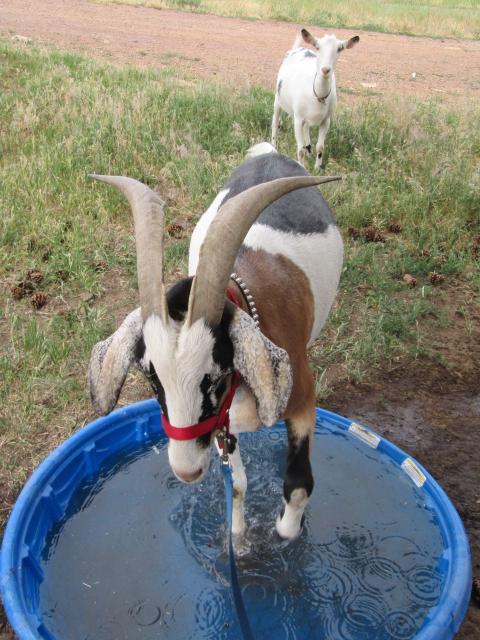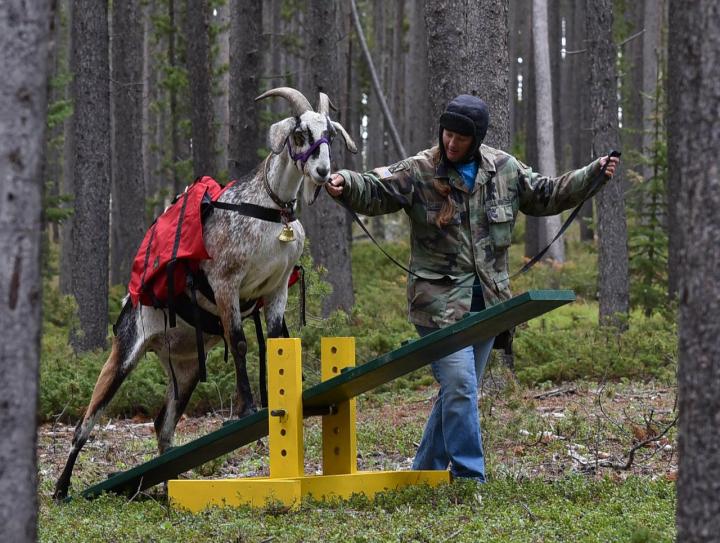Sled Drag (moderate):
Have the goat drag a sled weighed down with about 15 lbs. so it doesn't slither and bounce. Putting firewood or camping gear in the sled makes this obstacle feel practical. Make sure the drag rope has a handle loop and is long enough that the sled can't hit the goat's back legs. Goats with packsaddles should have the rope looped around the front crossbuck. If the goat does not have a saddle, the handler should lead the goat with one hand and drag the sled with the other. Have them pull the sled around a marker and back, otherwise the obstacle will have to be reset after each contestant. You can vary this obstacle by having the goat drag a tree branch or other item. Just make sure it's something a child can easily pull. You can also make the obstacle more difficult by having the goat drag a "spookum" such as a bunch of empty milk jugs tied together, or a bag full of rattling aluminum cans.

Stepping Stumps (moderate):
Set up a series of 3-5 stumps and have the goat step from one to the other without touching the ground. This obstacle seems easy, but most goats have a tendency to step down between or abandon the stumps entirely in favor of walking on the ground. Make sure the stumps are large enough to accommodate a full grown goat and that they are short and wide enough to prevent wobbling or tipping. Space them at such a distance that the average goat can step from one to the other without jumping.

Hoof Care (easy to moderate):
This is an easier version of the ground tying challenge because the handler never has to leave the goat. Place a marker on the ground with a hoof brush on it. The goat should stop next to the marker while the handler picks up the hoof brush and drops the goat's leash on the ground. The handler then picks up the goat's left front foot and brushes it clean. To make this obstacle easier, have the handler hold the leash over one arm or grip it between their knees. To make it harder, have the handler clean all four hooves. The goat should stand still and be obedient about lifting his feet.
Water Crossing (moderate to difficult):
Depending on how you set it up, this can be one of the most challenging obstacles on any course. Fill a plastic paddle pool with water. Add dirt to the bottom for traction. To make this obstacle easier, put a stump in the center so the goat can hop across the pool without getting his feet wet. For an advanced class, the goats should be required to walk through the pool. This obstacle is often presented in amateur classes without the stump as an amusement for the audience since most goats absolutely will NOT step into the pool willingly and often both goat and handler end up wet. This isn't very fair since smaller goats can be dragged in and complete the obstacle without training because they haven't got the physical strength to avoid it. Adding a stepping stump reduces the spectacle, but it shows which goats lead willingly over water and which don't. Advanced competitors should be required to walk the goat across without the stump. The goat should step all four feet in the water as he crosses.


Teeter-Totter (easy to moderate):
A teeter-totter is a fun obstacle and usually easy for the goats depending on how it is constructed. An easy, low teeter-totter can be set up using a piece of plywood nailed to a round log. Make sure the teeter-totter goes smoothly back and forth. To increase the challenge, use a narrower board and raise the height of the fulcrum. Make sure that any teeter-totter you build is sturdy and can't fall over or collapse under the weight of a full-sized packgoat. Also make sure it is not slippery. The steeper the teeter-totter, the more important this is. You can add wooden traction strips to the board and/or paint the board using sand in your paint mixture.

Have the goat drag a sled weighed down with about 15 lbs. so it doesn't slither and bounce. Putting firewood or camping gear in the sled makes this obstacle feel practical. Make sure the drag rope has a handle loop and is long enough that the sled can't hit the goat's back legs. Goats with packsaddles should have the rope looped around the front crossbuck. If the goat does not have a saddle, the handler should lead the goat with one hand and drag the sled with the other. Have them pull the sled around a marker and back, otherwise the obstacle will have to be reset after each contestant. You can vary this obstacle by having the goat drag a tree branch or other item. Just make sure it's something a child can easily pull. You can also make the obstacle more difficult by having the goat drag a "spookum" such as a bunch of empty milk jugs tied together, or a bag full of rattling aluminum cans.

Stepping Stumps (moderate):
Set up a series of 3-5 stumps and have the goat step from one to the other without touching the ground. This obstacle seems easy, but most goats have a tendency to step down between or abandon the stumps entirely in favor of walking on the ground. Make sure the stumps are large enough to accommodate a full grown goat and that they are short and wide enough to prevent wobbling or tipping. Space them at such a distance that the average goat can step from one to the other without jumping.

Hoof Care (easy to moderate):
This is an easier version of the ground tying challenge because the handler never has to leave the goat. Place a marker on the ground with a hoof brush on it. The goat should stop next to the marker while the handler picks up the hoof brush and drops the goat's leash on the ground. The handler then picks up the goat's left front foot and brushes it clean. To make this obstacle easier, have the handler hold the leash over one arm or grip it between their knees. To make it harder, have the handler clean all four hooves. The goat should stand still and be obedient about lifting his feet.
Water Crossing (moderate to difficult):
Depending on how you set it up, this can be one of the most challenging obstacles on any course. Fill a plastic paddle pool with water. Add dirt to the bottom for traction. To make this obstacle easier, put a stump in the center so the goat can hop across the pool without getting his feet wet. For an advanced class, the goats should be required to walk through the pool. This obstacle is often presented in amateur classes without the stump as an amusement for the audience since most goats absolutely will NOT step into the pool willingly and often both goat and handler end up wet. This isn't very fair since smaller goats can be dragged in and complete the obstacle without training because they haven't got the physical strength to avoid it. Adding a stepping stump reduces the spectacle, but it shows which goats lead willingly over water and which don't. Advanced competitors should be required to walk the goat across without the stump. The goat should step all four feet in the water as he crosses.


Teeter-Totter (easy to moderate):
A teeter-totter is a fun obstacle and usually easy for the goats depending on how it is constructed. An easy, low teeter-totter can be set up using a piece of plywood nailed to a round log. Make sure the teeter-totter goes smoothly back and forth. To increase the challenge, use a narrower board and raise the height of the fulcrum. Make sure that any teeter-totter you build is sturdy and can't fall over or collapse under the weight of a full-sized packgoat. Also make sure it is not slippery. The steeper the teeter-totter, the more important this is. You can add wooden traction strips to the board and/or paint the board using sand in your paint mixture.





